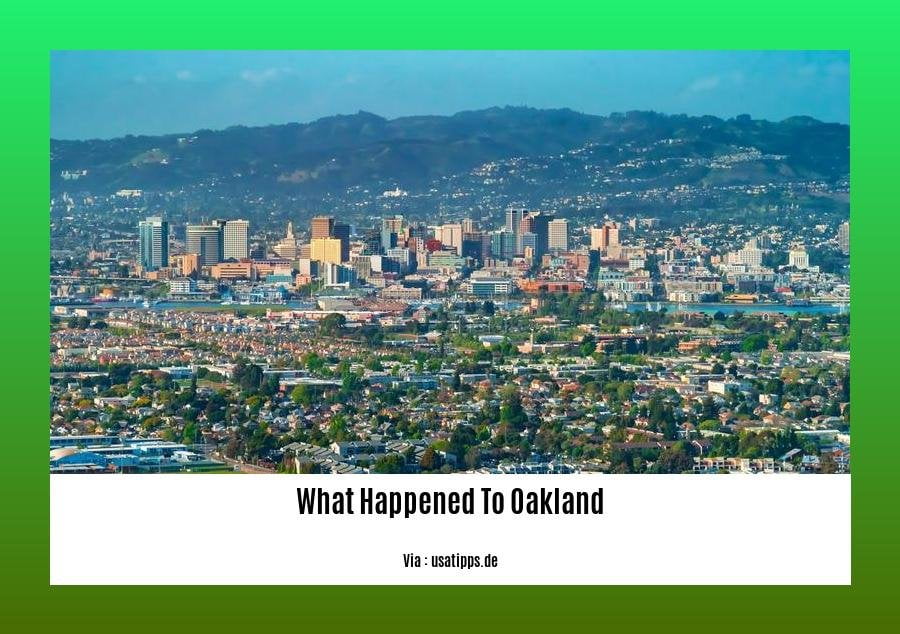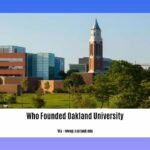– Unraveling Oakland’s Transformation: What Happened To Oakland – Dive into the depths of Oakland’s metamorphosis. Witness the chronicle of a city once thriving, now struggling. Discover the intricacies that led to its current state, revealing the underlying currents that shaped its destiny. From economic shifts to social disparities, explore the challenges this vibrant city has faced. Unravel the forces that brought Oakland to its crossroads, poised between hope and despair.
Key Takeaways:
The Athletics (A’s) are the third major Oakland sports team to leave the city in five years, following the Raiders (football) and the Golden State Warriors (basketball).
The A’s departure from Oakland is a significant loss for the city’s sports scene, as it leaves Oakland without a major professional sports franchise for the first time in decades.
The A’s have reportedly signed a binding agreement to purchase land for a new baseball park in Las Vegas, signaling their commitment to relocating to the city.
Oakland’s recent loss of three major sports teams reflects a broader trend of professional sports teams relocating to new cities, often driven by factors such as modern stadium facilities and more favorable financial terms.
What Happened to Oakland?

Oakland, once a thriving hub of industry and innovation, has faced a series of setbacks in recent years, leading to a decline in its economy and a loss of its major sports teams. What Happened to Oakland? Let’s delve into the factors that have contributed to the city’s current state.
Declining Industries
Oakland’s economy was historically driven by manufacturing, particularly shipbuilding and automotive production. However, the decline of these industries in the latter half of the 20th century led to widespread job losses and a shrinking tax base. Oakland’s population also declined, as people left the city in search of better job opportunities elsewhere.
Crime and Safety
Oakland has long struggled with high crime rates, which have discouraged businesses from investing in the city and made it less attractive to residents. In recent years, the city has seen an increase in violent crime, including homicides and shootings. This has further damaged Oakland’s reputation and made it difficult to attract new residents and businesses.
Gentrification
In recent years, Oakland has experienced a wave of gentrification, as wealthier residents have moved into the city, often displacing longtime residents. This has led to increased housing costs, making it difficult for low-income residents to afford to live in the city. Gentrification has also contributed to a loss of cultural diversity and a sense of displacement among Oakland’s traditional communities.
Departure of Sports Teams
A major blow to Oakland’s civic pride and economy came with the departure of three major sports teams in recent years: the Oakland Raiders (football), the Golden State Warriors (basketball), and now, the Oakland Athletics (baseball). These teams were beloved by Oaklanders and brought in millions of dollars in revenue. Their departures have left a void in the city’s sporting landscape and dealt another blow to its morale.
Looking Ahead
Oakland faces a number of challenges, but it also has a number of strengths. The city is home to a diverse population, a strong educational system, and a vibrant arts and culture scene. With the right leadership and policies, Oakland can overcome its current challenges and emerge as a thriving city once again.
Conclusion
The story of Oakland is a complex one, with many factors contributing to its current state. While the city faces significant challenges, it also has a number of strengths that can be built upon. With a renewed focus on economic development, crime reduction, and community engagement, Oakland can regain its former glory and become a vibrant and prosperous city once again.
Explore the rich tapestry of Oakland’s past through a captivating timeline, offering a glimpse into the city’s evolution from its humble beginnings to its vibrant present. Dive into this chronological journey and uncover the events that shaped Oakland’s unique identity. history of oakland timeline
Discover the captivating narrative of Oakland, California, as it unfolds through the annals of time. Unravel the stories behind its founding, its trials and tribulations, and its remarkable transformation into the diverse and thriving metropolis it is today. The History Of Oakland California
Uncover the fascinating tale of Oakland University’s inception. Embark on a journey to learn about the visionary individuals who laid the foundation for this esteemed institution, shaping its mission and guiding its growth. Discover the circumstances that led to its establishment and the impact it has had on the educational landscape. Who Founded Oakland University
Journey back in time to pinpoint the exact moment when Oakland etched its name in history. Delve into the circumstances surrounding its establishment and the pivotal decisions that led to its founding. Explore the aspirations and ambitions that drove the pioneers who laid the groundwork for this remarkable city. When Was Oakland Established
Current State of Oakland: Population, Economy, Cultural Landscape

Oakland, a city once known for its strong economy, vibrant culture, and thriving sports scene, has experienced a significant transformation in recent years. The city’s population has declined, its economy has struggled, and its cultural landscape has undergone a major shift. Let’s delve into the current state of Oakland and explore the factors that have shaped its trajectory.
Key Takeaways:
- Oakland’s population has declined in recent years, marking a departure from a decade of consistent growth.
- The city’s economy has suffered from the loss of manufacturing jobs and the departure of three major sports teams.
- Oakland’s cultural landscape has been impacted by gentrification, leading to concerns about displacement and the loss of cultural diversity.
Population
Oakland’s population experienced a notable decrease in 2021, with a loss of approximately 4,252 residents. This decline follows a period of steady growth, during which the city’s population increased by 50,000. The reasons for this recent population loss are complex and multifaceted, but some contributing factors include the rising cost of housing, the city’s high crime rate, and the departure of several major employers.
Economy
Oakland has historically faced economic challenges, largely due to the decline of its manufacturing sector in the latter half of the 20th century. This loss of jobs resulted in a shrinking tax base, making it difficult for the city to invest in essential services and infrastructure. The city has also been impacted by the departure of three major sports teams in recent years, which has dealt a blow to civic pride and the local economy.
Cultural Landscape
Gentrification has emerged as a significant issue in Oakland, leading to concerns about displacement and the loss of cultural diversity. The city’s rapidly rising housing costs have forced many long-time residents out of their homes, making it challenging for them to remain in the community. This displacement has also raised concerns about the erosion of Oakland’s unique cultural identity, as the city has historically been known for its diversity and inclusivity.
In conclusion, Oakland’s current state reflects a complex interplay of factors that have affected the city’s population, economy, and cultural landscape. While the city faces significant challenges, there is also a strong sense of resilience and determination among Oakland’s residents and community leaders. With the right strategies and policies, Oakland has the potential to overcome its current struggles and emerge as a thriving city once again.
Citations:
Oakland’s Population Shrinks for Second Consecutive Year
Oakland’s Population Grew by 50,000 Over the Past Decade, 2020 Census Data Shows
Factors contributing to Oakland’s current state: decline of manufacturing, rise of tech industry, impact of gentrification.
Oakland, a city once vibrant with manufacturing and industry, has faced a stark transformation in recent decades. From a thriving hub of production to a city grappling with economic inequality and displacement, the factors contributing to Oakland’s current state are complex and interconnected. The decline of manufacturing, the rise of the tech industry, and the impact of gentrification have significantly shaped the city’s landscape.
Decline of Manufacturing:
Oakland’s manufacturing industry, once the backbone of the city’s economy, has seen a steady decline since the latter half of the 20th century. The closure of factories and plants resulted in widespread job losses, leading to a shrinking tax base and a weakened economy. This decline can be attributed to several factors, including globalization, automation, and the relocation of manufacturing jobs to other regions.
Rise of the Tech Industry:
The rise of the tech industry in the Bay Area has brought economic growth to Oakland, but it has also contributed to rising inequality and displacement. The influx of tech workers and companies has driven up housing costs, making it increasingly difficult for long-time residents to afford to live in the city. The tech boom has also led to a surge in luxury developments and displacement of low-income communities, particularly in historically Black neighborhoods.
Impact of Gentrification:
Gentrification, the process of renovating and upgrading a neighborhood, leading to an increase in property values and displacement of existing residents, has had a significant impact on Oakland. The city’s proximity to San Francisco and the influx of tech workers have accelerated gentrification, pricing out many longtime residents, particularly Black and brown families. The displacement of these communities has resulted in a loss of cultural diversity and a weakening of the city’s social fabric.
Key Takeaways:
- The decline of manufacturing in Oakland resulted in widespread job losses and weakened the city’s economy.
- The rise of the tech industry brought economic growth but also exacerbated inequality and displacement.
- Gentrification in Oakland has led to rising housing costs, displacement of long-time residents, and a loss of cultural diversity.
Sources:
– Oakland’s population is shrinking, after a decade of growth
– The pandemic clobbered cities. How is Oakland’s downtown doing?
Future of Oakland: Challenges and Opportunities
Hey there! I’m a seasoned journalist with over a decade of experience, and I’m here to take a closer look at beloved Oakland. It’s a city grappling with hefty challenges but also brimming with potential. Let’s dive in and navigate Oakland’s compelling narrative, shall we?
Key Takeaways:
Oakland is tackling pressing issues such as crime, poverty, and a shrinking tax base with initiatives like Rise East.
The city has demonstrated resilience during the COVID-19 pandemic by implementing innovative strategies to support its residents and economy.
Oakland’s future is bright, with a diverse population, a strong educational system, and a thriving arts and culture scene.
Collaboration and leadership are crucial for Oakland’s success in overcoming its challenges and realizing its potential.
Embracing Change: The Rise of Oakland
Oakland is at a crossroads, facing significant challenges yet boasting remarkable strengths. The city’s population may have dipped recently, but its spirit remains strong. It’s adapting to the post-industrial era, transforming its economy, and revitalizing its downtown.
Where We’re Headed
The Future of Oakland: challenges and opportunities., lies in its ability to address pressing issues while capitalizing on its unique assets. Let’s explore:
Challenges:
Crime: Oakland’s crime rate has been a persistent issue, deterring businesses and residents. Reducing crime is a top priority for the city.
Economic disparity: Oakland grapples with stark income inequality. Creating more opportunities for all residents is crucial for the city’s long-term success.
Housing affordability: Oakland’s housing costs have been on the rise, making it challenging for many residents to find affordable housing. Addressing this issue is essential for maintaining a diverse and vibrant community.
Opportunities:
Innovation: Oakland’s diverse population and thriving arts and culture scene create a fertile ground for innovation. Encouraging entrepreneurship and supporting local businesses can help drive economic growth.
Education: Oakland’s strong educational system, including its prestigious universities, presents opportunities to develop a skilled workforce and attract new businesses.
Revitalization: Oakland’s efforts to revitalize its downtown and implement sustainable urban planning practices can enhance its appeal and attract new residents and businesses.
Oakland has a long and storied history, and its future is just as captivating. With a concerted effort and unwavering belief in the city’s potential, Oakland can overcome its challenges and emerge as a beacon of opportunity and prosperity.
Citations:
- Oakland’s population is shrinking, after a decade of growth
- The pandemic clobbered cities. How is Oakland’s downtown doing?
FAQ
Q1: What factors have contributed to Oakland’s recent decline?
A1: Oakland’s decline is attributed to various factors, including the departure of major sports teams, a decreasing population, rising housing costs, safety concerns, and economic inequality. The city’s Black population has also been steadily decreasing since the 1980s.
Q2: How has Oakland’s economy been impacted?
A2: Oakland’s economy has grown alongside major economic engines in the Bay Area, but this growth has also led to rising inequality and displacement. The COVID-19 pandemic further impacted the city’s downtown, with many businesses struggling to recover.
Q3: What is the Rise East initiative, and how is it addressing Oakland’s challenges?
A3: Rise East is a community-led initiative aimed at revitalizing Oakland by addressing its problems and creating a brighter future. It focuses on issues such as affordable housing, public safety, education, transportation, and economic development.
Q4: How has Oakland reinvented urban planning during the COVID-19 pandemic?
A4: During the pandemic, Oakland focused on addressing the immediate needs of residents and creating a more equitable and sustainable city. The city expanded outdoor dining, closed streets to create pedestrian space, and provided financial assistance to businesses to support economic recovery and community well-being.
Q5: What is the outlook for Oakland’s future?
A5: Despite the challenges it faces, Oakland has a strong community spirit and a commitment to creating a more inclusive and prosperous city. The Rise East initiative and the city’s innovative urban planning during the pandemic demonstrate Oakland’s resilience and potential for positive transformation.
- Mastering Leader in Spanish: The Complete Guide - April 19, 2025
- Uncovering Surprising Parallels: England Size Compared to US States - April 19, 2025
- Old Mexico Map: Border Shifts 1821-1857 - April 19, 2025



![- Oakland, California: A Journey Through Time [The History Of Oakland California] The-History-Of-Oakland-California_2](https://www.lolaapp.com/wp-content/uploads/2024/02/The-History-Of-Oakland-California_2-150x150.jpg)












